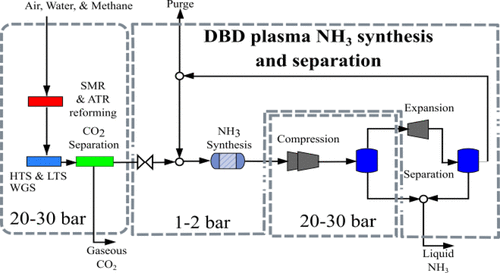当前位置:
X-MOL 学术
›
ACS Sustain. Chem. Eng.
›
论文详情
Our official English website, www.x-mol.net, welcomes your
feedback! (Note: you will need to create a separate account there.)
Atmospheric Pressure DBD Plasma Ammonia Synthesis and Separation Process Design and Environmental Impact Assessment
ACS Sustainable Chemistry & Engineering ( IF 7.1 ) Pub Date : 2021-09-21 , DOI: 10.1021/acssuschemeng.1c04031 Theodore Riotto 1 , Guoqiang Cao 1 , William L. Luyben 1 , Jonas Baltrusaitis 1
ACS Sustainable Chemistry & Engineering ( IF 7.1 ) Pub Date : 2021-09-21 , DOI: 10.1021/acssuschemeng.1c04031 Theodore Riotto 1 , Guoqiang Cao 1 , William L. Luyben 1 , Jonas Baltrusaitis 1
Affiliation

|
Engineering more sustainable ammonia (NH3) production methods is of utmost importance since the conventional synthesis process utilizes high temperatures and high pressures. In this work, the substitution of the conventional NH3 reactor operating at 160 bar with a dielectric discharge barrier (DBD) plasma reactor operating at atmospheric pressure was performed using the overall process design approach and the corresponding environmental impact assessment was calculated using Life Cycle Analysis. In particular, a plasma DBD NH3 reactor was modeled to operate at near atmospheric pressure and 150 °C using a forming gas obtained in the conventional methane reforming unit to obtain ∼1600 tonnes/day of liquid NH3 for large-scale fertilizer production. The resulting gaseous effluent was compressed to 25 bar and expanded to cool down and condense gaseous NH3 product resulting in a significant pressure decrease across the process. However, state-of-the-art reported N2 per pass conversion of 5–10% used in the current model results in large recycle and high compressor work. The single limiting factor preventing the favorable process economics was very high-energy consumption to generate plasma requiring ∼1758 MWe at the reported 37.9 g/kWh, which is the highest NH3 yield reported in the literature for DBD plasma reactors. The model obtained suggested that $0.007/kWh electricity cost could result in a breakeven for such a process. Across the board, much larger environmental impacts in the process utilizing a plasma NH3 reactor were obtained due to the significant increase in electricity use when compared to the conventional process when modeled as coming from the typical U.S. grid mix. Utilizing only 100% wind-derived electricity to power a plasma NH3 reactor provided certain environmental benefits with the compression/separation section becoming the main greenhouse gas contributor. The data presented here suggest that, while the low-pressure DBD plasma-based NH3 production process carries a promise of enhancing the sustainability of the NH3 production, significant improvements in the reactor efficiency are needed for it to become cost-competitive or result in improved environmental impact.
中文翻译:

常压DBD等离子氨合成分离工艺设计及环境影响评价
设计更可持续的氨 (NH 3 ) 生产方法至关重要,因为传统的合成过程使用高温和高压。在这项工作中,使用整体工艺设计方法将在 160 bar 下运行的传统 NH 3反应器替换为在大气压下运行的介质放电势垒 (DBD) 等离子体反应器,并使用生命周期分析计算相应的环境影响评估. 特别是,等离子体 DBD NH 3反应器被建模为在接近大气压和 150 °C 下运行,使用在传统甲烷重整装置中获得的合成气,以获得约 1600 吨/天的液态 NH 3用于大规模化肥生产。所得气态流出物被压缩至25巴并膨胀以冷却和冷凝气态NH 3产物,导致整个过程的压力显着降低。然而,当前模型中使用的最新技术报告的 N 2单程转化率为 5-10%,导致大量循环和高压缩机工作。阻碍有利工艺经济性的单一限制因素是产生等离子体的能量消耗非常高,在报告的 37.9 g/kWh 下需要 ~1758 MWe,这是最高的 NH 3DBD 等离子体反应器文献中报道的产率。获得的模型表明,0.007 美元/千瓦时的电费可能会导致这种过程的收支平衡。总体而言,在使用等离子体 NH 3反应器的过程中获得了更大的环境影响,因为与来自典型美国电网混合模型的传统过程相比,电力使用显着增加。仅使用 100% 风电为等离子体 NH 3反应器提供动力提供了一定的环境效益,压缩/分离部分成为主要的温室气体贡献者。这里提供的数据表明,虽然低压 DBD 等离子体基 NH 3由于生产过程有望提高 NH 3生产的可持续性,因此需要显着提高反应器效率才能使其具有成本竞争力或改善环境影响。
更新日期:2021-10-04
中文翻译:

常压DBD等离子氨合成分离工艺设计及环境影响评价
设计更可持续的氨 (NH 3 ) 生产方法至关重要,因为传统的合成过程使用高温和高压。在这项工作中,使用整体工艺设计方法将在 160 bar 下运行的传统 NH 3反应器替换为在大气压下运行的介质放电势垒 (DBD) 等离子体反应器,并使用生命周期分析计算相应的环境影响评估. 特别是,等离子体 DBD NH 3反应器被建模为在接近大气压和 150 °C 下运行,使用在传统甲烷重整装置中获得的合成气,以获得约 1600 吨/天的液态 NH 3用于大规模化肥生产。所得气态流出物被压缩至25巴并膨胀以冷却和冷凝气态NH 3产物,导致整个过程的压力显着降低。然而,当前模型中使用的最新技术报告的 N 2单程转化率为 5-10%,导致大量循环和高压缩机工作。阻碍有利工艺经济性的单一限制因素是产生等离子体的能量消耗非常高,在报告的 37.9 g/kWh 下需要 ~1758 MWe,这是最高的 NH 3DBD 等离子体反应器文献中报道的产率。获得的模型表明,0.007 美元/千瓦时的电费可能会导致这种过程的收支平衡。总体而言,在使用等离子体 NH 3反应器的过程中获得了更大的环境影响,因为与来自典型美国电网混合模型的传统过程相比,电力使用显着增加。仅使用 100% 风电为等离子体 NH 3反应器提供动力提供了一定的环境效益,压缩/分离部分成为主要的温室气体贡献者。这里提供的数据表明,虽然低压 DBD 等离子体基 NH 3由于生产过程有望提高 NH 3生产的可持续性,因此需要显着提高反应器效率才能使其具有成本竞争力或改善环境影响。











































 京公网安备 11010802027423号
京公网安备 11010802027423号